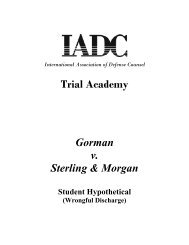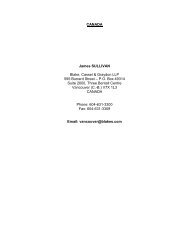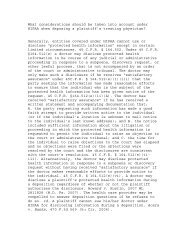Defense Counsel Journal - International Association of Defense ...
Defense Counsel Journal - International Association of Defense ...
Defense Counsel Journal - International Association of Defense ...
You also want an ePaper? Increase the reach of your titles
YUMPU automatically turns print PDFs into web optimized ePapers that Google loves.
Page 476 DEFENSE COUNSEL JOURNAL–October 2012and replacing the stucco (which may ormay not be covered, depending onwhether it was performed by asubcontractor) from the cost <strong>of</strong> repairingthe damaged structural elements (alleged“other property”)?This issue becomes more complex onclose examination. For example, a wiseinsured will argue that it is not possible toaccess the framing members withoutremoving the stucco. Therefore, forargument’s sake, even if the waterintrusion resulted from a different cause,even non-defective stucco would have tobe removed and replaced as part <strong>of</strong> thecost <strong>of</strong> repairing the damaged structuralelements. The players involved are justbeginning, relatively speaking, to addressthat kind <strong>of</strong> issue, sometimes referred toas “rip and tear” damages.In addition, as a result <strong>of</strong> thesubcontractor exception, which is almostuniversally recognized, contractorssimply use subcontractors for all work ona project. Clearly, had the builder inJ.S.U.B. done its own site preparation, itwould have deprived itself <strong>of</strong> coveragewhich it otherwise enjoyed. Of course,subcontractors purchasing the same formCGL policy usually do not have thatoption.There are also the ever-present issues<strong>of</strong> indemnity, subrogation andcontribution. The builder who utilizedsubcontractors and/or its insurer will havean excellent argument that the entireliability should be passed down the line tothe subcontractors. Certainly, U.S. Fireshould have a right <strong>of</strong> subrogation topursue the site preparation contractor forindemnity since the builder cannot havecontributed to the loss. In that case, is thesubcontractor’s insurer in any betterposition to deny coverage than thebuilder’s insurer would have been sincethe subcontractor exception should notapply? That question is debatable giventhe “rationale” used by the FloridaSupreme Court to conclude that defectiveconstruction is an “occurrence.” Onecould certainly cite that decision for theproposition that defective construction isonly an “occurrence” when the work isperformed by a subcontractor. For thesubcontractor then, is there no“occurrence” because the subcontractordid not use a sub-subcontractor? That is aquestion which will also likely belitigated in the coming years.III. Legislating CoverageIn states where the courts’ decisionshave been unfavorable to policyholders,policyholders have turned to lobbyists,the plaintiffs’ bar and state legislatures toenact change. For example, recentlegislation reversed a decision by theSouth Carolina Supreme Court inCrossmann Communities <strong>of</strong> NorthCarolina v. Harleysville MutualInsurance. 25 The court (which laterwithdrew the opinion and reversed itself),held that damages resulting from faultyworkmanship were the “natural andprobable cause” <strong>of</strong> the faulty work and, assuch, did not qualify as an “occurrence.”In response, the South CarolinaLegislature passed a statute providing:Commercial general liabilityinsurance policies shall containor be deemed to contain a25 No. 26909, 2011 W.L. 93716 (S.C. Jan 7,2011).












